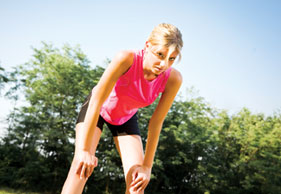When I’m racing, I always get a sharp pain just under my breast. I try to avoid any liquids before the race and for the first few kilometres. The pain slows me down as I have to reduce my pace. I sometimes take deep breaths in and out to ease the pain, which helps for a while. What should I do? – NDANGANENI MUDAU, NEDBANK RUNNING CLUB, JOHANNESBURG
EXPERT ANSWER
A stitch is an intense stabbing pain under the lower edge of the ribcage that occurs while exercising. It is due to a cramp in the diaphragm, the large muscle that separates the abdominal and chest cavities. The inner organs of the abdominal cavity hang from several flimsy ligaments that are fixed to the diaphragm. These inner organs, the liver, spleen, stomach, small intestines and colon, weigh several kilograms and the impact of every step causes them to pull on the diaphragm. This continuous up and down movement and the stress on the diaphragm may cause a cramp (stitch).
About 65-75% of stitches occur on the right side of the body, because the liver, by far the heaviest of the abdominal organs, is located on the right. As one breathes out, the diaphragm moves up to force air out of the lungs. Therefore, exhaling as the right foot hits the ground exerts greater force on the liver – and the diaphragm.
The most commonly recommended treatments are related to changing your breathing pattern: if the pain is on the right side, make sure you exhale as the left foot hits the ground and inhale when the right foot hits. Or reduce the frequency of breathing by inhaling for four steps and exhaling for three. Another common treatment is to increase the strength of the diaphragm and improve oxygenation by learning how to belly breathe while running. Belly breathing involves breathing in deeply while simultaneously pushing your stomach out like a balloon. As you breathe out, your stomach should sink in.
Other treatment suggestions include:
• Stopping and lying down with elevated legs
• Pressing your fingers into the painful spot and blowing out through pursed lips
• Cutting out fatty, high protein foods prior to exercise
• Slowing down your pace, as fast running increases the ground reaction forces
• Stretching by raising one arm and leaning to the opposite side
• Relaxing your body, as stitches may occur more frequently in a tense athlete
Modern Athlete Expert – TONY HESP
Physiotherapist in Edenvale, Johannesburg. Has finished 20 Comrades, three Ironmans and two New York Marathons, plus various cycling and canoeing events. Member of Jeppe Quondam.


